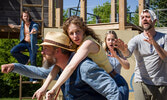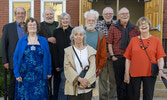'The Farm Show: Then and Now' bridges eras to open Blyth Festival 50th season
BY SHAWN LOUGHLIN
Once upon a time, when Keith Roulston (one of the founders of the Blyth Festival - heard of him?) and I worked in the same office, we would discuss the plays of the Blyth Festival... though only after I’d written my review of the show.
Keith and I would find ourselves at the same opening night shows and, in my early days of writing reviews, I’d ask him what he thought of the show when I first saw him in the morning. He’d inevitably ask if I’d yet written my review and if I told him I hadn’t, he’d simply walk on.
You see, he didn’t want to influence my opinion of what I’d seen in any way.
That’s all a bit of prologue to the opening night of The Farm Show: Then and Now, which opened on the Festival’s Harvest Stage on Friday night. For someone who’s been privy to Festival history for nearly 20 years now, the audience was a who’s who of the Festival’s 50-year history. At least two of the Festival’s three founders were in attendance, along with all living creators of The Farm Show and even some of those profiled in the original show and surely I didn’t see or recognize many, many others who were there that night.
It was a night for all of those who had a hand in getting the Festival from its first season to its 50th. I say all of that to set the scene of sitting directly behind Ted Johns and Janet Amos, two of the most prominent figures in Festival (and Canadian theatre) history and co-creators of The Farm Show, last Friday. As they watched their creation be relived, revisited and, at times, reinterpreted, it was hard not to take cues or be influenced by how they were receiving the play.
While I dutifully watched every scene for the first time (and while I have heard Farm Show lore for nearly 20 years, I never had the chance to see it before Friday night), I couldn’t help but find the reactions of Ted and Janet much more interesting than my own. I was wondering what they liked (it seemed like a lot, though I wouldn’t dare speak for Ted or Janet), what they remembered from those hot Huron County days in the early 1970s and what it was like seeing a young cast perform their show more than 50 years after they first performed it as a young cast themselves. I wondered if they missed their dearly-departed friend and Farm Show co-creator David Fox, who was eulogized within the show alongside Ray Bird, the farmer whose barn played host to the first-ever production of The Farm Show. I also couldn’t help but wonder if they ever thought their weird and wonderful summer near Clinton - and the show they made about it - would still be celebrated all these years later.
With all of that being said, it didn’t influence my opinion of the show, but it certainly put it into some historical context. You can be told that plays are written about real people and true stories, but having those people sit in the audience with you as you watch it paints an entirely different picture - certainly more than just about any conversation Keith and I could have had in our old office together.
And now, without further ado, onto the show! The Farm Show: Then and Now begins with a preamble. Fiona Mongillo, Hallie Seline, Landon Doak, Jamie Mac and Geoffrey Armour - the cast of five, short one of the original cast of six, perhaps by design as a tribute - takes to the stage and speaks to us, the audience. Here they are - actors (this season’s cast) portraying actors (The Farm Show creators) portraying the farmers and rural residents of Goderich Township and the Clinton area in the early 1970s. The suspension of disbelief, in terms of the actors, the story on the stage and the items being used as props, will be necessary.
Festival Artistic Director Gil Garratt, who also directed the show, makes some special appearances over the course of the story being told, further breaking the fourth wall within a show that proves to be a habitual fourth wall breaker.
For someone like me, who has had fleeting glimpses of imagery from the original show or heard recollections of some of the most memorable scenes, there were times that I felt at home, knowing a bit about the scene I was seeing, despite not seeing it before. There was Doak’s take on the famous Miles Potter scene about the wild world of storing hay, Seline cross-legged giving us Fina MacDonell’s ducks, a creative take on the International Plowing Match and, of course, the human tractor ridden by Doak’s Potter - which serves as the show’s art by Autumn Ducharme and based on a photograph from the original production.
You can tell this cast of actors has relished being part of this moment in history (revisiting another moment in history). Their commitment is clear and the fun they’re having on stage is infectious. There is so much to watch - the sound is cacophonous at times, while at other times a scene will simply go on as actors embody animals in the background, providing what could be considered scenery all too familiar to anyone who’s visited a Huron County farm.
All five actors (and Garratt) are tremendous and it’s impossible to force a reviewer to put forward a standout for consideration. Though, as someone who knew and admired Fox, I kept returning to Mac’s version of Fox playing farmer Les Gervais. Tremendous.
The exhausting physical acting has the cast portraying everything from chickens, rams and deer to tractors, water wheels and bridges, in addition to all of the people whose stories they work to tell. It really is a feat of physical theatre.
Aside from the meta framing device (actors portraying actors portraying farmers) and a few updates and tributes to Fox and Bird, the show largely sticks to the script of the Theatre Passe Muraille production from all those years ago (which wasn’t written down until after more than a year of performances). And that’s a good thing.
Garratt and the cast could almost be seen as being in an unenviable position by taking this project on. Letting the project speak for itself, all these years on, could come with its own challenges, while getting trigger-happy with updates is sure to be fraught with its own peril, especially among purists like Festival founders, original creators and more. And yet they seem to have struck a good balance.
Furthermore, both those inside and out of farming can’t help but notice the echoes of conversations being had in the world of farming in 1972 that still reverberate here in 2024. Food prices - who’s complaining about them and who’s getting rich off of them - are a talking point, right alongside the nearly-impossible task of making a living as a farmer and the even more nearly-impossible task of getting into farming as a young person. Issues then, issues now.
And while it’s true that the more things change, the more they stay the same, it was impossible not to think about the passage of time watching the show with all of those creative geniuses in the audience. Once young and bounding around the stage with limitless energy like today’s cast, but now older and watching with decades more of experience in their eyes, it served as a reminder of just how long 50 years is and all that can change, be grown and be gained and lost in that time.
There is no guarantee that a theatre like the Blyth Festival, a big swing to rival some of the biggest swings, lives to see a second season, let alone a 50th. What James Roy, Anne Chislett and Keith Roulston founded all those years ago appears to be alive and thriving, embracing its past while looking to its future. And now, arriving at the end of my review, I can tell Keith that myself.
The Farm Show: Then and Now is on the Festival’s Harvest Stage until Aug. 4.


